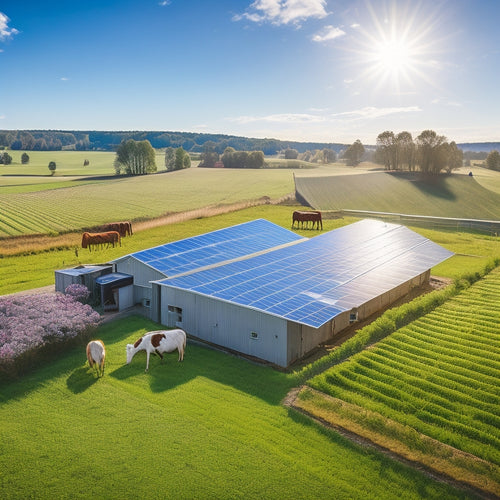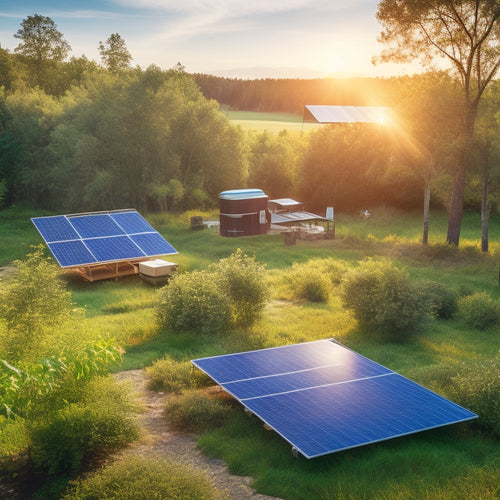
Why Are Large Solar Panels More Efficient
Share
Large solar panels are more efficient because they have a larger surface area, allowing them to capture more sunlight. This increased light absorption results in higher energy output per panel. Innovations in panel design, such as textured surfaces and bifacial cells, enhance their ability to convert sunlight into electricity effectively. Additionally, fewer large panels are needed, simplifying installation and reducing costs. They also tend to have a longer lifespan and lower maintenance requirements, making them a sustainable choice. You might find it interesting how these factors collectively contribute to ideal solar energy solutions.
At a Glance
- Larger solar panels have increased surface area, allowing for greater light absorption and higher energy conversion efficiency.
- Advancements in solar technology, like bifacial cells, enhance the performance of larger panels, capturing sunlight from multiple angles.
- Fewer larger panels are needed for the same energy output, which streamlines installation and reduces labor costs.
- Optimized designs and advanced materials in larger panels improve durability, efficiency, and overall performance metrics.
- Larger panels mitigate shading effects and maintain consistent energy yield throughout the day, contributing to better energy independence.
Higher Energy Output per Panel
When you consider large solar panels, their increased surface area plays an essential role in capturing more sunlight, resulting in higher energy output per panel.
This is particularly important as advancements in solar technology continue to improve energy conversion rates.
Additionally, the integration of advanced technologies, such as bifacial cells and better inverter systems, enhances efficiency and optimizes performance.
These factors combined allow you to maximize energy generation, making large solar panels an attractive choice for sustainable energy solutions.
Increased Surface Area
With an increased surface area, large solar panels noticeably improve their energy output per panel. This is primarily due to the ability of larger panels to capture more sunlight throughout the day. When you consider various solar panel types, larger models often include more photovoltaic cells, which directly correlates to a higher energy conversion rate. This means you can generate more electricity without needing to install additional panels, effectively maximizing your space and resources.
Moreover, effective installation techniques play an essential role in maximizing this surface area advantage. Proper angling and positioning of these larger panels guarantee they receive ideal sunlight exposure, further enhancing their efficiency. By strategically placing them in areas with minimal shading and maximizing their tilt, you can considerably improve their performance.
In essence, choosing larger solar panels not only increases your energy output per panel but also contributes to a more sustainable energy solution. This efficiency aligns with your desire for freedom from traditional energy sources, allowing you to utilize the power of the sun more effectively and reduce your dependence on fossil fuels.
Advanced Technology Integration
Advanced technology integration in large solar panels greatly improves their energy output per panel. By utilizing advancements like smart grid integration, these systems can optimize energy distribution in real time. This means your solar panels can communicate with the grid to balance energy supply and demand effectively, guaranteeing minimal energy loss and maximizing efficiency.
Additionally, predictive maintenance plays a critical role in enhancing performance. With data analytics and IoT sensors, you can monitor the health of each panel and anticipate potential issues before they escalate. This proactive approach not only extends the lifespan of your solar panels but also guarantees they operate at peak efficiency.
When you combine these technologies, you enable your solar energy system to adapt and respond to changing conditions, whether it's weather fluctuations or shifts in energy demand. This adaptability leads to higher energy output per panel, making large solar installations more viable and appealing for those seeking energy independence.
Ultimately, advanced technology integration alters the way you utilize solar energy, aligning with your desire for freedom and sustainability.
Increased Surface Area Advantage
When you consider large solar panels, their increased surface area greatly improves light absorption.
This larger expanse allows for more photons to be captured, leading to greater energy conversion efficiency.
Additionally, high-efficiency solar panels often exceed standard performance metrics, further enhancing energy production capabilities.
As a result, you can expect a notable improvement in overall energy output compared to smaller panels.
Enhanced Light Absorption
Many solar panel designs employ enhanced light absorption by maximizing surface area, which greatly amplifies energy capture. When you increase the panel's surface area, you facilitate more effective light trapping, allowing the system to capture a wider range of sunlight. This wider capture enhances the spectral response, meaning the panel can convert more wavelengths of light into usable energy.
Larger panels can incorporate advanced materials and textures that optimize light absorption. For instance, textured surfaces can scatter incoming light, increasing the probability of photon absorption. This design feature is essential because it minimizes reflection and maximizes the amount of light that penetrates the solar cells.
Moreover, with greater surface area, you have more room for additional photovoltaic cells, each contributing to the overall energy output. This collaboration greatly enhances the panel's efficiency.
As a result, when you consider the implications of enhanced light absorption, it's clear that larger solar panels not only capture more sunlight but also effectively convert it into energy. This advancement supports your quest for energy independence and sustainability, ultimately enabling you to capture the sun's power more effectively.
Greater Energy Conversion
Enhanced light absorption directly contributes to greater energy conversion, especially as larger solar panels make use of increased surface area. By maximizing this surface area, you can capture more sunlight, allowing for higher energy output.
Different solar panel types, including monocrystalline and polycrystalline, exhibit varying energy efficiency factors, but larger panels generally perform better due to their expansive reach.
When considering installation, larger panels often reduce the number needed, streamlining the overall setup and potentially lowering labor costs. However, installation considerations must account for structural integrity and local regulations.
Maintenance practices also play a critical role; larger systems may require more extensive upkeep, but their efficiency gains can offset these needs.
In a thorough cost analysis, you'll find that the initial investment in larger panels can yield significant long-term savings through higher energy production.
Additionally, market trends indicate a growing preference for larger solar panels, fueled by technological advancements that enhance durability and efficiency.
Ultimately, adopting larger solar technology not only increases personal energy independence but also minimizes environmental impact, aligning with a commitment to sustainable living.
Panel Design Innovations
When considering panel design innovations, you'll want to focus on the use of advanced materials that enhance efficiency and durability.
Breakthroughs in next-gen photovoltaic materials considerably improve energy absorption, allowing for greater sunlight capture. These materials not only improve energy conversion rates but also contribute to optimized surface area, maximizing sunlight capture.
Advanced Materials Usage
The evolution of solar panel design is greatly influenced by the incorporation of advanced materials, driving improvements in efficiency and durability. By optimizing material composition, manufacturers are able to enhance performance metrics considerably. For instance, the use of high-efficiency silicon combined with innovative compounds can lead to a more resilient panel that withstands environmental stressors.
Technological advancements in manufacturing processes also play an essential role. These processes have become more refined, allowing for better integration of materials that reduce the environmental impact of production. Furthermore, these innovations contribute to cost efficiency, making solar energy more accessible.
Durability factors are vital; advanced materials not only prolong the lifespan of panels but also facilitate effective recycling methods. This guarantees that when panels reach the end of their life cycle, they can be repurposed, minimizing waste and supporting sustainable practices.
Optimized Surface Area
With a focus on optimizing surface area, recent panel design innovations have notably improved the efficiency of solar energy capture. You might wonder how this optimization plays out in practical terms. By strategically increasing panel sizing, manufacturers can enhance the amount of sunlight absorbed, thereby elevating solar efficiency. Larger panels expose more photovoltaic cells to sunlight, maximizing energy conversion rates.
Moreover, advancements in panel design have led to the development of bifacial solar panels, which employ both sides for energy capture. This dual-facing capability allows you to leverage reflected sunlight from the ground, further increasing energy output without requiring additional space.
Another innovation involves the use of textured surfaces that scatter light more effectively, ensuring that even low-angle sunlight contributes to energy generation. This design not only optimizes surface area but also mitigates the effects of shading, allowing for a more consistent energy yield throughout the day.
As you consider solar options, keep in mind that optimizing surface area through innovative panel sizing and design can greatly enhance your energy independence and lower costs. Embracing these advancements can help you access the full potential of solar energy.
Selecting Based on Energy Goals
When selecting large solar panels, consider your specific energy output goals to guarantee peak efficiency.
It's also essential to verify manufacturer authenticity online to avoid counterfeit products that could affect performance.
Assess how much space you have available, as this will impact the number and size of panels you can install.
Balancing these factors will help you achieve a sustainable energy solution customized to your needs.
Energy Output Considerations
Selecting solar panels based on your energy goals requires a clear understanding of energy output considerations. When evaluating solar panel scaling, it's essential to assess how larger panels can improve your system's overall energy efficiency metrics.
Larger solar panels typically generate more energy per square foot, allowing you to maximize output without requiring extensive space. To align your selection with your energy needs, consider the peak wattage of the panels. Higher wattage indicates greater energy output, which is significant if you aim for energy independence or wish to reduce reliance on the grid.
Additionally, analyze the efficiency ratings of different panels. Higher efficiency means more sunlight conversion into usable energy, providing better returns on your investment.
Moreover, factor in environmental conditions like shading, orientation, and local climate, as these can influence performance. By understanding these considerations, you can make informed choices that align with your energy goals.
Ultimately, selecting the right solar panels enables you to optimize energy generation, leveraging the full potential of solar technology to achieve your vision of freedom and sustainability.
Space Utilization Strategies
Maximizing the efficiency of your solar energy system isn't just about choosing the right panels; it also involves strategic space utilization. To achieve ideal results, consider innovative installation techniques that enhance space efficiency, especially in urban applications where every square foot counts.
Utilizing modular designs allows for flexible configurations, ensuring you can adapt the system to fit your specific energy goals. Incorporating solar tracking technology can greatly increase energy capture throughout the day by adjusting the panels' angles to follow the sun.
Additionally, effective shading solutions can mitigate performance losses caused by nearby structures or trees. Roof integration serves as a dual-purpose approach, combining aesthetics with functionality, allowing for seamless incorporation into your home's design.
Don't overlook the importance of maintenance practices, as keeping your system clean and well-maintained will maximize its lifespan and efficiency.
Longer Lifespan Than Competitors
When you consider large solar panels, their durability directly impacts performance stability over time.
These panels are engineered to withstand various environmental challenges, ensuring they maintain efficiency longer than many competitors.
Durability and Performance Stability
Durability and performance stability in large solar panels are essential for ensuring long-term energy production and reliability. These panels are engineered with advanced materials that enhance their weather resistance, allowing them to endure harsh conditions without significant degradation.
When you consider maintenance requirements, large solar panels often demand less upkeep compared to smaller counterparts, translating to lower operational costs over time. Moreover, their superior performance metrics contribute to a higher energy yield, impacting the overall environmental impact positively.
A lifecycle assessment reveals that, while initial installation obstacles may arise, the long-term benefits outweigh these challenges, especially regarding material sustainability and cost effectiveness. Larger panels can produce more energy per square foot, making them a more attractive option as market trends shift towards sustainability.
Aesthetic considerations also play a role; larger panels can be integrated into designs that are visually appealing while maximizing energy output. By choosing large solar panels, you're not just investing in energy efficiency but also embracing a solution that aligns with your desire for freedom through sustainable living and reduced dependency on conventional energy sources.
Frequently Asked Questions
How Do Large Solar Panels Affect Installation Costs?
Large solar panels can streamline installation logistics, reducing labor and equipment needs. You'll find that a thorough cost analysis often reveals lower overall expenses, making them a more economical choice for your energy independence.
Are Larger Solar Panels Heavier Than Smaller Ones?
When you compare the weight of larger and smaller solar panels, the dimensions play an essential role. Typically, larger panels weigh more due to increased materials, impacting installation and overall system design considerations.
Do Larger Panels Require More Maintenance?
Larger panels typically don't require more maintenance, but their durability can influence maintenance frequency. You'll find that sturdy designs often lead to less frequent upkeep, allowing you to enjoy the benefits of solar energy longer.
Can Large Solar Panels Fit on All Rooftops?
About 80% of residential rooftops can accommodate large solar panels, offering significant installation flexibility. However, constraints like rooftop space, orientation, and shading may limit their fit. Assess your rooftop's unique characteristics to maximize solar potential.
What Is the Warranty Typically Offered for Large Solar Panels?
When considering large solar panels, you'll typically find a warranty duration of 20 to 25 years, often coupled with a performance guarantee. This guarantees their efficiency remains high throughout the lifespan, providing you peace of mind.
Explore More
To summarize, large solar panels offer undeniable advantages, from higher energy output to innovative designs that maximize efficiency. When you consider your energy goals, the choice becomes clear. But what if you could tap into even more power than you thought possible? As technology continues to evolve and improve, the potential for larger panels could reshape energy production. So, are you ready to unleash the full potential of solar energy and revolutionize your energy environment? The future awaits.
Related Posts
-

What Do I Need to Know About Farm Solar Panels
When considering farm solar panels, you need to assess costs, benefits, and technical specifics. Initial investment c...
-

Why Outdoor Solar Lighting Systems Are Sustainable
Outdoor solar lighting systems are sustainable because they utilize renewable energy, drastically reducing your carbo...
-

Top Off Grid Solar Batteries for Renewable Energy
When seeking top off-grid solar batteries for renewable energy, consider options with advanced battery chemistry, suc...


